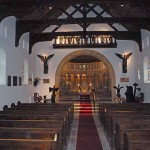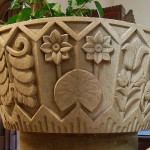If I were compiling a secret history of architecture—those unpedigreed works of genius that stand outside the mainstream—I would include Gaudí, of course, but also many lesser figures: Henry Chapman Mercer, the builder of several amazing concrete structures in Doylestown, Pennsylvania; Paul Chalfin, the creative force behind that ebullient Baroque pile, Vizcaya, in Miami; and Simon Rodia, creator of Watts Towers in LA. I would also have to add my friend, George Holt in Charleston, whose Byzantine concoctions have no contemporary analog. There would also be a number of women in this company: Theodate Pope whose Avon Old Farms School anticipate Hobbits; Mary Elizabeth Jane Colter, who designed the wonderful stone structures that grace the rim of the Grand Canyon; and Sarah Losh, the subject of a new biography by Jenny Unglow. Losh (1786-1853) built little—a country church, a schoolhouse and a sexton’s cottage—but what she did build is exceptional, and exceptionally original. The small church of St. Mary’s in the village of Wreay in the Cumbrian hills, where she lived, anticipates the Romanesque revival, but also includes personal decoration that has no historical antecedents: column capitals in the form of lotus buds; gargoyles in the form of winged turtles; a baptismal font carved (by Losh herself) with floral patterns; and a profusion of pinecones. Quite wonderful


